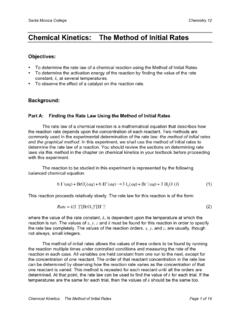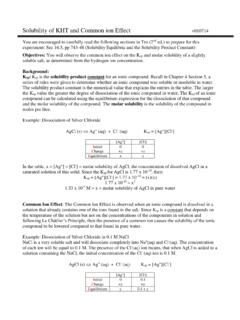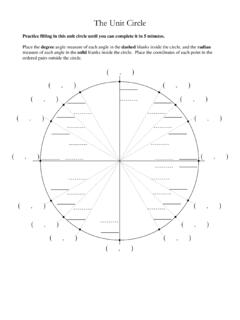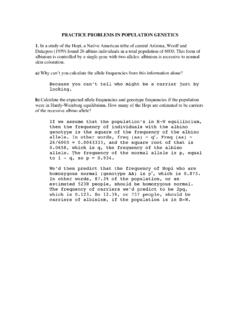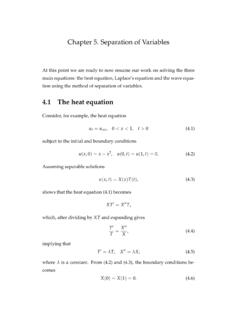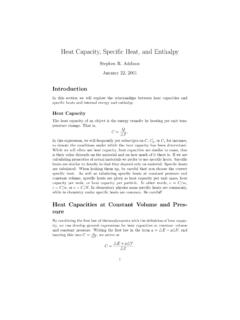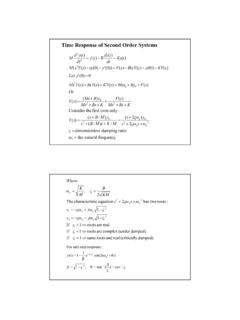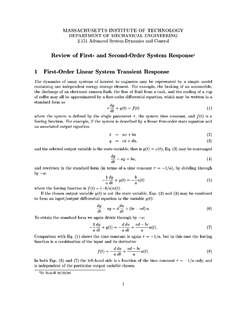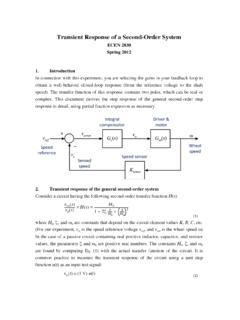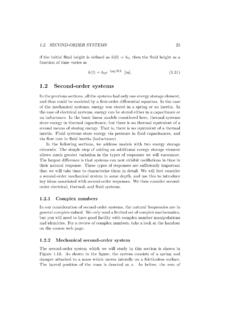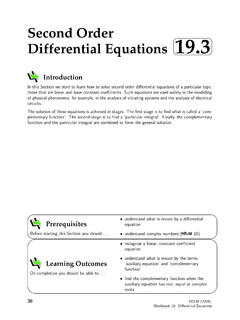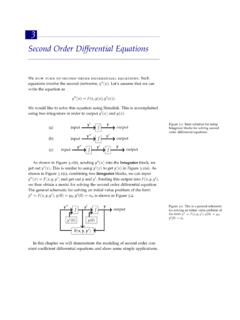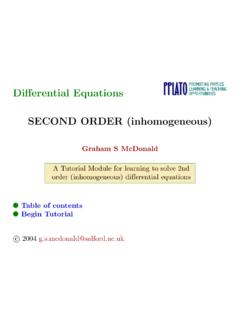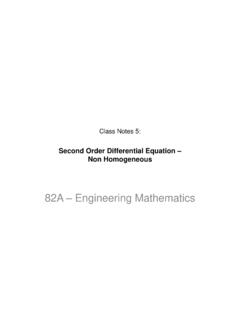Transcription of Chapter 3. Second Order Linear PDEs - UCA
1 Chapter 3. Second Order Linear IntroductionThe general class of Second Order Linear PDEs are of the form:a(x,y)uxx+b(x,y)uxy+c(x,y)uyy+d(x,y )ux+e(x,y)uy+f(x,y)u=g(x,y).( )The three PDEs that lie at the cornerstone of applied mathematics are: theheat equation, the wave equation and Laplace s equation, (i)ut=uxx,the heat equation(ii)utt=uxx,the wave equation(iii)uxx+uyy=0,Laplace s equationor, using the same independent variables,xandy(i)uxx uy=0,the heat equation( )(ii)uxx uyy=0,the wave equation( )(iii)uxx+uyy= s equation( )Analogous to characterizing quadratic equationsax2+bxy+cy2+dx+ey+f=0,as either hyperbolic, parabolic or elliptic determined byb2 4ac>0,hyperbolic,b2 4ac=0,parabolic,b2 4ac<0,elliptic,2 Chapter 3.
2 Linear Second Order Equationswe do the same for PDEs. So, for the heat equationa=1,b=0,c=0sob2 4ac=0 and so the heat equation is parabolic. Similarly, the waveequation is hyperbolic and Laplace s equation is elliptic. This leads to anatural question. Is it possible to transform one PDE to another where thenew PDE is simpler? Namely, under a change of variabler=r(x,y),s=s(x,y),can we transform to one of the followingcanonicalforms:urr uss+ ,hyperbolic,( )uss+ ,parabolic,( )urr+uss+ ,elliptic,( )where the term stands for lower Order terms. For example, con-sider the PDE2uxx 2uxy+5uyy=0.
3 ( )This equation is elliptic since the ellipticb2 4ac=4 40= 36<0. Ifwe introduce new coordinates,r=2x+y,s=x y,then by a change of variable using the chain ruleuxx=urrr2x+2ursrxsx+usss2x+urrxx+uss xx,uxy=urrrxry+urs(rxsy+rysx) +usssxsy+urrxy+ussxy,uyy=urrr2y+2ursrysy +usss2y+urryy+ussyy,givesuxx=4urr+4urs+u ss,uxy=2urr urs uss,uyy=urr 2urs+ Introduction3 Under ( ), equation ( ) becomesurr+uss=0,which is Laplace s equation (also elliptic). Before we consider transforma-tions for PDEs in general, it is important to determine whether the equa-tion type could change under transformation.
4 Consider the general classof PDEsauxx+buxy+cuyy=0( )wherea,b, andcare functions ofxandyand noting that we have sup-pressed the lower terms as they will not affect the type. Under a change ofvariable(x,y) (r,s)with the change of variable formulas ( ) givesa(urrr2x+2ursrxsx+usss2x+urrxx+ussx x)+b(urrrxry+urs(rxsy+rysx) +usssxsy+urrxy+ussxy)( )+c(uyy+urrr2y+2ursrysy+usss2y+urryy+uss yy)=0 Rearranging ( ), and again neglecting lower Order terms, gives(ar2x+brxry+cr2y)urr+ (2arxsx+b(rxsy+rysx) +2crysy)urs( )+ (as2x+bsxsy+cs2y)uss= +brxry+cr2y,B=2arxsx+b(rxsy+rysx) +2crysy,( )C=as2x+bsxsy+cs2y,gives (again suppressing lower Order terms)Aurr+Burs+Cuss=0,whose type is given byB2 4AC= (b2 4ac)(rxsy rysx)2,4 Chapter 3.
5 Linear Second Order Equationsfrom which we deduce thatb2 4ac>0, B2 4AC>0,b2 4ac=0, B2 4AC=0,b2 4ac<0, B2 4AC<0,giving that the equation type is unchanged under transformation. We nowconsider transformations to canonical form. As there are three types ofcanonical forms, hyperbolic, parabolic and elliptic, we will deal with eachtype Canonical FormsIf we introduce the change of coordinatesr=r(x,y),s=s(x,y),( )the derivatives change according to:First Orderux=urrx+ussx,uy=urry+ussy,( ) Second Orderuxx=urrr2x+2ursrxsx+usss2x+urrxx+us sxx,uxy=urrrxry+urs(rxsy+rysx) +usssxsy+urrxy+ussxy, ( )uyy=urrr2y+2ursrysy+usss2y+urryy+ussyy, If we substitute ( ) and ( ) into the general Linear equation ( ) andre-arrange we obtain(ar2x+brxry+cr2y)urr+(2arxsx+b(rxs y+rysx) +2crysy)urs+ (as2x+bsxsy+cs2y)uss+ ( )Our goal now is to target a given canonical form and solve a set of equa-tions for the new Canonical Parabolic Canonical FormComparing ( ) with the parabolic canonical form ( )
6 Leads to choos-ingar2x+brxry+cr2y=0,( )2arxsx+b(rxsy+rysx) +2crysy=0,( )Since in the parabolic caseb2 4ac=0, then substitutingc=b24awe findboth equations of ( ) are satisfied if2arx+bry=0.( )with the choice ofs(x,y)arbitrary. The following examples +6uxy+9uyy=0.( )Here,a=1,b=6 andc=9 showing thatb2 4ac=0, so the PDE isparabolic. Solvingrx+3ry=0,givesr=f(3x y).As we wish to find new coordinates as to transform the original equationto canonical form, we chooser=3x y,s= Second derivativesuxx=9urr,uxy= 3urr+3urs,uyy=urr 2urs+uss.( )Substituting ( ) into ( ) givesuss=0!
7 Not to be confused with factorial (!).6 Chapter 3. Linear Second Order EquationsSolving givesu=f(r)s+g(r).wherefandgare arbitrary functions. In terms of the original variables,we obtain the solutionu=y f(3x y) +g(3x y).Example 4xyuxy+4y2uyy+xux=0.( )Here,a=x2,b= 4xyandc=4y2showing thatb2 4ac=0, so the PDEis parabolic. Solvingx2rx 2xyry=0,orxrx 2yry=0,givesr=f(x2y).As we wish to find new coordinates, , we choose simpler=x2y,s= first derivatives givesux=2xyur.( )Calculating Second derivativesuxx=4x2y2urr+2yur,( )uxy=2x3yurr+2xyurs+2xur,( )uyy=x4urr+2x2urs+uss.( )Substituting ( ) and ( ) into ( ) gives4y2uss 4x2yur= Canonical Forms7or, in terms of the new variables,rands,uss rs2ur=0.
8 ( )An interesting question is whether different choices of the arbitrary func-tionfand the variableswould lead to a different canonical forms. Forexample, suppose we choser=2 lnx+lny,s=lny,we would obtainuss ur us=0,( )a constant coefficient parabolic equation, whereas, choosingr=2 lnx+lny,s=2 lnx,we would obtainuss ur=0,( )the heat Hyperbolic Canonical FormIn Order to obtain the canonical form for the hyperbolic type, uss+ ,( )it is necessary to choosear2x+brxry+cr2y= (as2x+bsxsy+cs2y),2arxsx+b(rxsy+rysx) +2crysy=0.( )The problem is that this system is still a very hard problem to solve (bothPDEs are nonlinear and coupled!)
9 Therefore, we introduce a modified hy-perbolic form that is much easier to work 3. Linear Second Order Modified Hyperbolic FormThe modified hyperbolic canonical form is defined asurs+ ,( )noting thata=0,b=1 andc=0 and thatb2 4ac>0 still! In Order totarget the modified hyperbolic form, it is now necessary to choosear2x+brxry+cr2y=0,( )as2x+bsxsy+cs2y=0.( )If we re-write ( ) and ( ) as followsa(rxry)2+2brxry+c=0,( )a(sxsy)2+2bsxsy+c=0,( )then we can solve equations ( ) and ( ) separately leads to two first Order Linear PDEs forrands. The solutions of thesethen gives rise to the correct canonical variables.
10 The following 5uxy+6uyy=0( )Here,a=1,b= 5 andc=6 showing thatb2 4ac=1>0, so the PDEis hyperbolic. Thus, ( ) becomesr2x 5rxry+6r2y=0,s2x 5sxry+6s2y=0,and factoring gives(rx 2ry)(rx 3ry)=0,(sx 2sy)(sx 3sy)=0, Canonical Forms9from which we chooserx 2ry=0,sx 3sy=0,giving rise to solutionsr=f(2x+y),s=g(3x+y).As we wish to find new co-ordinates as to transform the original equationto canonical form, we chooser=2x+y,s=3x+ Second derivativesuxx=4urr+12urs+9uss,uxy=2urr+ 5urs+3uss,( )uyy=urr+2urs+ ( ) into ( ) givesurs= givesu=f(r) +g(s).wherefandgare arbitrary functions. In terms of the original variables,we obtain the solutionu=f(2x+y) +g(3x+y).
